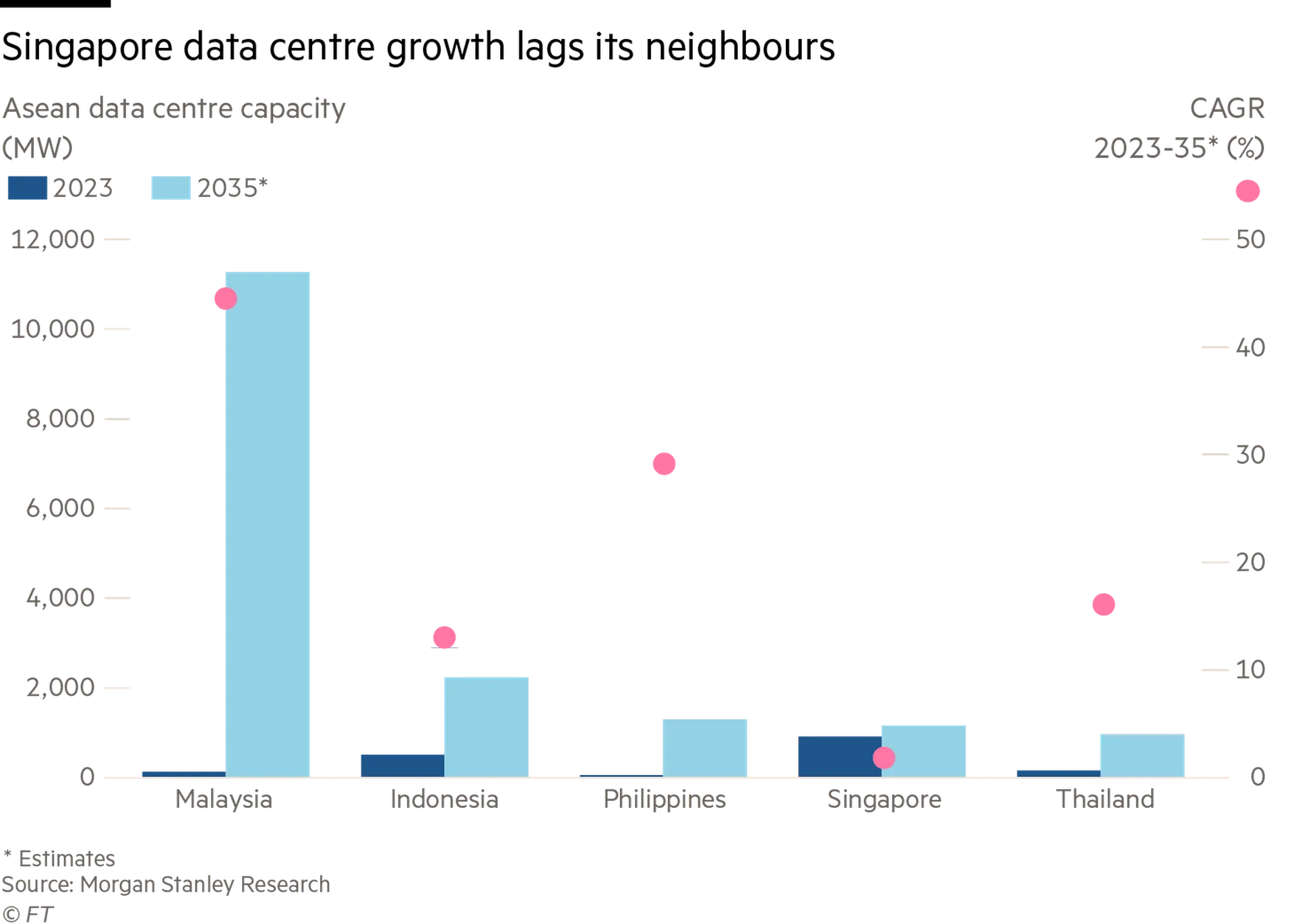尊敬的用戶您好,這是來自FT中文網的溫馨提示:如您對更多FT中文網的內容感興趣,請在蘋果應用商店或谷歌應用市場搜尋「FT中文網」,下載FT中文網的官方應用。
Singaporeans are a competitive bunch. One of the must-know Singlish words for those living in the city-state is kiasu. The Chinese Hokkien term roughly means a fear of missing or losing out and often refers to someone trying to get ahead of others. “Fomo on steroids” is how one Singaporean friend describes it.
新加坡人是一羣有競爭力的人。對於居住在這個城市國家的人來說,必須要知道的新加坡英語(Singlish)辭彙之一就是「kiasu」(驚輸,意爲「怕輸」)。這個閩南語詞的大致意思是害怕錯過或落後,通常指某人試圖超越他人。一位新加坡朋友對此的形容是「加強版Fomo」(Fomo即Fear of missing out的縮寫,意爲「害怕錯過」)。
One of the best places to see this in action is the queues at lunchtime around stalls of the city-state’s favourite hawker food markets. Another area to observe the kiasu mentality in the Asian financial centre is in business, such as foreign investment.
最能體現這一點的地方之一是新加坡最受歡迎的熟食市場在午餐時間排起的長隊。另一個可以觀察到這個亞洲金融中心的「怕輸」心態的領域是商業,比如外國投資。
Singapore made a surprise announcement last month that it would free up more power for data centre expansion. The move came as the chief executives of Nvidia, Google, Microsoft and others have been swinging by neighbouring Malaysia — and other countries in south-east Asia — in recent months pledging billions in data centre investment.
新加坡上月意外宣佈,將爲數據中心擴張提供更多電力。最近幾個月,輝達(Nvidia)、谷歌(Google)、微軟(Microsoft)等公司首席執行長紛紛訪問鄰國馬來西亞及其他東南亞國家,承諾在數據中心投資上投入數十億美元。
In Malaysia alone, the tech groups — three of the top four biggest companies by market capitalisation globally — have committed $8.5bn in new data centre, cloud and artificial intelligence investment in the past six months. Which is why more than one Malaysian government official joked that Singapore’s decision to court more data centres was a “typical Singapore kiasu response” to its neighbour’s progress.
僅在馬來西亞,上述科技集團(全球四大市值最高公司中的三家)在過去6個月裏已經承諾投資85億美元用於新的數據中心、雲端計算和人工智慧。這就是爲什麼不止一位馬來西亞政府官員開玩笑說,新加坡決定爭取更多的數據中心,是對鄰國進展的「典型新加坡怕輸反應」。
Of course there is some competition between Singapore and its neighbours, especially Malaysia from which it gained independence in 1965. But it is overly simplistic to dismiss Singapore’s move as kiasu-ness — even if there is an element of that at play. The city-state is already hyper connected and one of the biggest data centre markets in Asia — a trend that accelerated as Hong Kong became a less favoured destination for data centres and undersea cables. It is one of the top submarine cable hubs globally, with connections to 25 active subsea cables and more to come. None of that will change soon.
當然,新加坡與其鄰國之間存在一些競爭,尤其是馬來西亞——新加坡在1965年從馬來西亞獨立出來。但是,將新加坡的舉動歸咎於「怕輸」,是過於簡單化的觀點——即使其中確實有這樣的因素。這個城市國家的網路已經非常發達,併成爲亞洲最大的數據中心市場之一——在香港作爲數據中心和海底電纜目的地不如以往那麼受青睞之後,這一趨勢加速發展。它是全球頂級的海底電纜樞紐之一,與25條活躍的海底電纜相連,未來還將有更多的連接。這一切都不會很快改變。
The decision to increase data centre capacity last month was a surprise to many because the government imposed a more than three-year moratorium on new data centres between 2019 and 2022. The proliferation of the energy-guzzling facilities had been consuming a substantial amount of Singapore’s resources. That ban helped push data centre companies into nearby Johor, the Malaysian state just across the causeway, and to a certain extent Batam, a close-by Indonesian island.
上月決定增加數據中心容量的舉措對許多人來說是個意外,因爲新加坡政府在2019年至2022年間對新數據中心實施了超過三年的禁令。這些耗能設施的大量增加一直在消耗新加坡的資源。而該禁令促使數據中心公司轉向附近的馬來西亞州柔佛,以及在一定程度上轉向附近的印尼島嶼巴淡島。

The conundrum Singapore faces now — like many other countries — is that it grossly underestimated how demand for AI is going to expand the global market for data centres in coming years. The city-state has made little secret of the fact that it wants to be the AI hub for south-east Asia, if not the top in Asia.
新加坡現在面臨的難題——就像許多其他國家一樣——是它嚴重低估了未來幾年人工智慧的需求將如何擴大全球數據中心市場。這個城市國家毫不掩飾它希望成爲東南亞的人工智慧中心,甚至成爲亞洲頂級中心。
That’s because being such a hub brings other economic benefits. For example, as part of Nvidia’s data centre investment in Malaysia, the company will partner with local conglomerate YTL Power to develop the country’s fastest supercomputers using Nvidia’s AI chips. Microsoft last month unveiled landmark AI infrastructure investments in Indonesia and Thailand.
這是因爲,成爲這樣一個樞紐能帶來其他經濟利益。例如,作爲輝達在馬來西亞數據中心投資的一部分,該公司將與當地的楊忠禮電力集團(YTL Power)合作,使用輝達的人工智慧晶片開發該國最快的超級電腦。微軟上月在印尼和泰國揭幕了具有里程碑意義的人工智慧基礎設施投資。
Singapore realises it cannot ultimately compete with its neighbours for land and power. The key is how to complement it. The reason Johor is popular with global tech giants from ByteDance to Nvidia and Microsoft is because it is just a few kilometres away from hyperconnected Singapore.
新加坡意識到,它無法與鄰國在土地和電力上進行最終競爭。關鍵在於如何相互補充。字節跳動(ByteDance)、輝達和微軟等全球科技巨擘之所以青睞柔佛,是因爲它距離網路發達的新加坡只有幾公里。
“Both Johor and Singapore can benefit from the data centre boom. They complement each other,” says Rangnath Salgame, chair and chief executive of Princeton Digital Group, an Asian data centre company based in Singapore but expanding in Johor. It is a “symbiotic relationship”, he adds.
「柔佛和新加坡都可以從數據中心的繁榮中受益。它們互相補充,」普林斯頓數字集團(Princeton Digital Group)的主席兼首席執行長蘭格納特•薩爾加姆(Rangnath Salgame)說道。該公司是一家總部位於新加坡但在柔佛擴張的亞洲數據中心公司。他補充說,這是一種「共生關係」。
And as more and more companies diversify supply chains away from China that puts Singapore in pole position. One way it can benefit is by promoting a Singapore + one strategy, whereby companies establish a headquarters in the country to leverage its international business environment, free trade agreements and access to professional talent, but then have their manufacturing — or data centre — facilities in places such as Johor.
隨著越來越多的公司將供應鏈從中國分散出去,新加坡佔據了領先地位。一種受益的方式是推動「新加坡+1」戰略,即公司在新加坡設立總部,利用其國際商業環境、自由貿易協定和專業人才,然後將製造業或數據中心設施設在柔佛等地。
This is already a long-term trend. Singapore was the top recipient of inward foreign direct investment flows in south-east Asia between 2013 and 2022, according to the latest data published by the bloc. In 2022, Singapore attracted $141bn of FDI, accounting for more than half of the region’s total. So should Singapore really be kiasu?
這已經是一個長期趨勢。根據東盟最新發布的數據,新加坡在2013年至2022年間成爲東南亞地區吸引外國直接投資流入最多的國家。2022年,新加坡吸引了1410億美元的外國直接投資,佔該地區總額的一半以上。那麼,新加坡真的應該「怕輸」嗎?